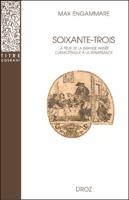Soixante-trois. La peur de la grande année climactérique à la Renaissance
Author(s)
Engammare, Max
Collection
OAPEN-CH 1st Call; Swiss National Science Foundation (SNF)Language
FrenchAbstract
People have interpreted the numeration of the years of their life since Antiquity (when, for example, the Emperor Augustus did so). Ancient medical theories thus maintained that matter is renewed every seven or nine years. The product of these two numbers is sixty-three, and the sixty-third year of a person’s life – the great climacteric – was believed to be very critical. Max Engammare presents the history of the anxiety surrounding this year that came back into force during the Renaissance, as early as Petrarch but especially with Marsilio Ficino. This book touches on most of the great names of the age, from Philipp Melanchthon and Theodore de Bèze to Rabelais. The question of the sixty-third king of France, Henri III or Henri IV, was also discussed by members of the League. The goal is to achieve an understanding of the arithmetic of these ancient fears that were reborn at the end of the 1400s and which have not in fact completely disappeared today—a proof of this is Sigmund Freud and the curse of 27 listing all the famous artists dead at the age of 27 (three times nine). Depuis l’Antiquité, les hommes ont interprété la numération des années de leur vie, tel l’empereur Auguste, autre manière de retenir le temps qui fuit. Des théories médicales ont ainsi avancé que la matière se renouvelait toutes les sept ou neuf années. Le produit de ces deux chiffres (l’un dévolu au corps, l’autre à l’esprit) donne soixante-trois, et la soixante-troisième année de la vie humaine, grande climactérique, était regardée comme très critique. C’est sous le signe du nombre et du temps que Max Engammare fait l’histoire de l’intérêt inquiet pour cette année qui reprend vigueur à la Renaissance, avec Pétrarque, mais surtout avec Marsile Ficin. On croisera la plupart des grands noms du temps, dont des théologiens, à l’instar de Philipp Melanchthon, le bras droit de Luther, et de Théodore de Bèze, celui de Calvin, mais aussi de Rabelais, celui qui a introduit le mot en français. La question du soixante-troisième roi de France, Henri III ou Henri IV, sera également posée par des Ligueurs qui ne savaient pas en 1587 ou 1588 que les deux mourraient assassinés, et l’on jouera même au jeu de l’oie. Il s’agit de comprendre l’arithmétique de ces peurs antiques réactualisées dès la fin du XVe siècle et qui n’ont pas complètement disparu aujourd’hui, preuve en est Sigmund Freud ou la soi-disant malédiction des 27 répertoriant tous les artistes célèbres morts à l’âge de vingt-sept ans (trois fois neuf).
Keywords
réforme; theology; théologie; calvinism; astrology; astrologie; horoscope; superstition; medicine; renaissance; poetry; calvinisme; reformation; poésie; médecineDOI
10.26530/OAPEN_579650ISBN
9782600005531OCN
1030817906Publisher
Librairie DrozPublisher website
https://www.droz.org/fr/Publication date and place
Genève, 2013Series
Titre courant, 53Classification
French
16th century, c 1500 to c 1599
Theology
Astrology


 Download
Download Web Shop
Web Shop